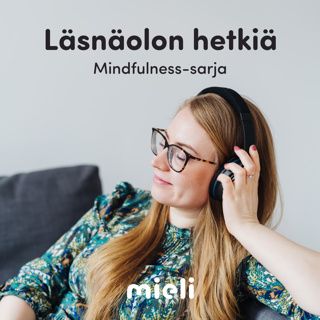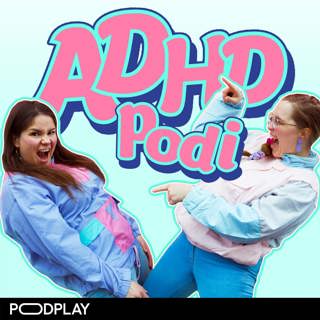
BONUS - Let's Get Physical! An Interview with BehaviorFit CEO, Nick Green
Subscribe on iTunes Subscribe on Google Play Subscribe on Stitcher Fresh off our last grab bag episode, Nick Green, CEO of BehaviorFit, joins us to discuss his article on decreasing sedentary behavior, to share how behavior analysis can be used to improve our health, and to question Rob on the utility of six-pack abs.
15 Maalis 201748min

Episode 26 - (ETHICS) How to Talk to Non-Behavior Analysts Without Really Trying
Subscribe on iTunes Subscribe on Google Play Subscribe on Stitcher It's our second ETHICS episode so gather around the ol' podcast table to learn how to disseminate behavior analysis to anyone and everyone without getting exiled from your place of employment. Here are some things you shouldn't do: 1) flip tables in a fit of rage when anyone proposes hippotherapy 2) break-up with your boyfriend over his insistence that a "mind-file" is a real thing and 3) use data sheets as deadly weapons. Oh, you wanted us to tell you what you should do? Guess you'll have to listen to the show. C'mon...there's discussion about a decision tree coming up! Articles discussed this episode: Bercirevic, A. (2014). Ask the Experts: How can new students defend behavior analysis from misunderstandings? Behavior Analysis in Practice, 7, 138-140. doi: 10.1007/s40617-014-0019-y Critchfield, T. (2014). Ten rules for discussing behavior analysis. Behavior Analysis in Practice, 7, 141-142. doi: 10.1007/s40617-014-0026-z Todd, J. (2014). Some useful resources for students who are tempted to bring enlightenment to errant non-behaviorists. Behavior Analysis in Practice, 7, 143-144. doi: 10.1007/s40617-014-0027-y Brodhead, M. (2015). Maintaining professional relationships in an interdisciplinary setting: Strategies for navigating nonbehavioral treatment recommendations for individuals with autism. Behavior Analysis in Practice, 8, 70-78. doi: 10.1007/s40617-015-0042-7 Luiselli, J. (2015). In response: Maintaining professional relationships in an interdisciplinary setting: Strategies for navigating non-behavioral treatment recommendations for individuals with autism. Behavior Analysis in Practice, 8, 79. doi: 10.1007/s40617-015-0043-6 If you're interested in ordering CEs for listening to this episode, click here to go to the store page. You'll need to enter your name, BCBA #, and the two episode secret code words to complete the purchase. Email us at abainsidetrack@gmail.com for further assistance.
8 Maalis 20171h 20min

Episode 26 Preview
Subscribe on iTunes Subscribe on Google Play Subscribe on Stitcher Subscribe on YouTube The only thing better than sharing the amazing science of behavior analysis to the masses is learning how to do it better and netting an ethics CE in the process. Everybody wins! Except for Jackie who has never seen Back to the Future and Diana who has never seen Aspergers R Us live and Rob who was so disappointed to learn that talking to non-behavior analysts actually did require trying. But, hey, at least we've updated the previous episodes page so you can find all of our classic capers. Articles for next week: Bercirevic, A. (2014). Ask the Experts: How can new students defend behavior analysis from misunderstandings? Behavior Analysis in Practice, 7, 138-140. doi: 10.1007/s40617-014-0019-y Critchfield, T. (2014). Ten rules for discussing behavior analysis. Behavior Analysis in Practice, 7, 141-142. doi: 10.1007/s40617-014-0026-z Todd, J. (2014). Some useful resources for students who are tempted to bring enlightenment to errant non-behaviorists. Behavior Analysis in Practice, 7, 143-144. doi: 10.1007/s40617-014-0027-y Brodhead, M. (2015). Maintaining professional relationships in an interdisciplinary setting: Strategies for navigating nonbehavioral treatment recommendations for individuals with autism. Behavior Analysis in Practice, 8, 70-78. doi: 10.1007/s40617-015-0042-7 Luiselli, J. (2015). In response: Maintaining professional relationships in an interdisciplinary setting: Strategies for navigating non-behavioral treatment recommendations for individuals with autism. Behavior Analysis in Practice, 8, 79. doi: 10.1007/s40617-015-0043-6
1 Maalis 201712min

Episode 25 - Virtual Reality
Subscribe on iTunes Subscribe on Google Play Subscribe on Stitcher If one were to enter the virtual world, could we really expect that person to come out the other side with great fire safety skills and a fearlessness about spiders? Well, this week we discuss two articles that say, "Yes." Featuring our very first call-in co-host, anecdotes galore about Rob's favorite video games, and more terrifying spider scenarios than you could shake a stick it. Strap on those VR headsets and step into the next level of research-based entertainment. And we never even mention that "Virtual Reality" song, because we refuse to make the easy references. And we ran out of money to license it. Articles discussed this episode: Bouchard, S., Cote, S., St-Jacques, J., Robillard, G., & Renaud, P. (2006). Effectiveness of virtual reality exposure in the treatment of arachnophobia using 3D games. Technology and Health Care, 14, 19-27. Padgett, L.S., Strickland, D., & Coles, C.D. (2006). Case study: Using a virtual reality computer game to teach fire safety skills to children diagnosed with fetal alcohol syndrome. Journal of Pediatric Psychology, 31, 65-70. doi: 10.1093/jpepsy/jsj030 And for the gravy: Morina, N., Ijntema, H., Meyerbroker, K., & Emmelkamp, P.M.G. (2015). Can virtual reality exposure therapy gains be generalized to real-life? A meta-analysis of studies applying behavioral assessments. Behaviour Research and Therapy, 74. 18-24. doi: 10.1016/j.brat.2015.08.010 If you're interested in ordering CEs for listening to this episode, click here to go to the store page. You'll need to enter your name, BCBA #, and the two episode secret code words to complete the purchase. Email us at abainsidetrack@gmail.com for further assistance.
22 Helmi 20171h 14min

Episode 25 Preview
Subscribe on iTunes Subscribe on Google Play Subscribe on Stitcher Subscribe on YouTube We're travelling onward into the virtual realm with articles on using virtual reality. But before the full-length discussions, we review just what VR is, and how you can do it too. Now including footage of Rob flying with a bunch of seagulls! And our 1000th Facebook like! Articles for next week: Bouchard, S., Cote, S., St-Jacques, J., Robillard, G., & Renaud, P. (2006). Effectiveness of virtual reality exposure in the treatment of arachnophobia using 3D games. Technology and Health Care, 14, 19-27. Padgett, L.S., Strickland, D., & Coles, C.D. (2006). Case study: Using a virtual reality computer game to teach fire safety skills to children diagnosed with fetal alcohol syndrome. Journal of Pediatric Psychology, 31, 65-70. doi: 10.1093/jpepsy/jsj030 And for the gravy: Morina, N., Ijntema, H., Meyerbroker, K., & Emmelkamp, P.M.G. (2015). Can virtual reality exposure therapy gains be generalized to real-life? A meta-analysis of studies applying behavioral assessments. Behaviour Research and Therapy, 74. 18-24. doi: 10.1016/j.brat.2015.08.010
15 Helmi 201713min

Episode 24 - Return of the Grab Bag!
Subscribe on iTunes Subscribe on Google Play Subscribe on Stitcher Behavior analysis runs wild and free, no longer bound by educational research in this, the Return of the Grab Bag! Between sharing tips for what to watch on maternity leave and positing which one of your hosts is actually a ghost, we discuss research related to taking medicine on time, breaking the cycle of procrastination, and getting off your butt. Is it really true that negative reinforcement makes the world go round? Count on your favorite space acquaintances to weigh in on that question and more. Articles discussed this episode: Johnson, Jr., P.E., Perrin, C.J., Salo, A., Deschaine, E., & Johnson, B. (2016). Use of an explicit rule decreases procrastination in university students. Journal of Applied Behavior Analysis, 49, 346-358. doi: 10.1002/jaba.287 Raiff, B.R., Jarvis, B.P., & Dallery, J. (2016). Text-message reminders plus incentives increase adherence to antidiabetic meication in adults with type 2 diabetes. Journal of Applied Behavior Analysis, 49, 947-953. doi: 10.1002/jaba.337 Green, N., Sigurdsson, S., & Wilder, D.A. (2016). Decreasing bouts of prolonged sitting among office workers. Journal of Applied Behavior Analysis, 49, 717-722. doi: 10.1002/jaba.309 If you're interested in ordering CEs for listening to this episode, click here to go to the store page. You'll need to enter your name, BCBA #, and the two episode secret code words to complete the purchase. Email us at abainsidetrack@gmail.com for further assistance.
8 Helmi 20171h 20min

Episode 24 Preview
Subscribe on iTunes Subscribe on Google Play Subscribe on Stitcher Subscribe on YouTube It's the Return of the Grab Bag and boy do we have a varied assortment of articles from the world of applied behavior analysis. Can we incentivize taking medication on time? How do we avoid sitting down all day until we die? And is it true that studying is an aversive event? Join us next week for the full episode where the answers to these questions and more will be revealed. Pardon our review of dance movies of the 00s; it's our first recording of 2017. Articles for next week: Johnson, Jr., P.E., Perrin, C.J., Salo, A., Deschaine, E., & Johnson, B. (2016). Use of an explicit rule decreases procrastination in university students. Journal of Applied Behavior Analysis, 49, 346-358. doi: 10.1002/jaba.287 Raiff, B.R., Jarvis, B.P., & Dallery, J. (2016). Text-message reminders plus incentives increase adherence to antidiabetic meication in adults with type 2 diabetes. Journal of Applied Behavior Analysis, 49, 947-953. doi: 10.1002/jaba.337 Green, N., Sigurdsson, S., & Wilder, D.A. (2016). Decreasing bouts of prolonged sitting among office workers. Journal of Applied Behavior Analysis, 49, 717-722. doi: 10.1002/jaba.309
1 Helmi 201711min

Episode 23 - Video Modeling
Subscribe on iTunes Subscribe on Google Play Subscribe on Stitcher It's the first full episode of the year and boy are we excited! Waaaay too excited! This week we're turning our camera onto the world to view the instructional method that is video modeling. While many of us may know how video modeling can teach children with autism simple play skills, did you know it can be used to teach reciprocal play? Social skills? You will at the end of our show. We also share bonus tips on how to spend the rest of your life working on your doctorate, the secret formula of Cadbury chocolate, whether the cast of Lost would pass the Sally Anne test, and the whimsical world of Wookie holidays. OH YEAH! Articles discussed this episode: MacDonald, R., Sacramone, S., Mansfield, R., Wiltz, K., & Ahearn, W.H. (2009). Using video modeling to teach reciprocal pretend play to children with autism. Journal of Applied Behavior Analysis, 42, 43-55. doi: 10.1901/jaba.2009.42-43 LeBlanc, L.A., Coates, A.M., Daneshvar, S., Charlop-Christy, M.H., Morris, C., & Lancaster, B.M. (2003). Using video modeling and reinforcement to teach perspective-taking skill to children with autism. Journal of Applied Behavior Analysis, 36, 253-257. 10.1901/jaba.2003.36-253 And for some additional information on prerequisites to success with video modeling, a bonus article: MacDonald, R.P.F., Dickson, C.A., Martineau, M., & Ahearn, W.H. (2015). Prerequisite skill that support learning through video modeling. Education and Treatment of Children, 38, 33-48. If you're interested in ordering CEs for listening to this episode, click here to go to the store page. You'll need to enter your name, BCBA #, and the two episode secret code words to complete the purchase. Email us at abainsidetrack@gmail.com for further assistance.
25 Tammi 20171h 17min






















